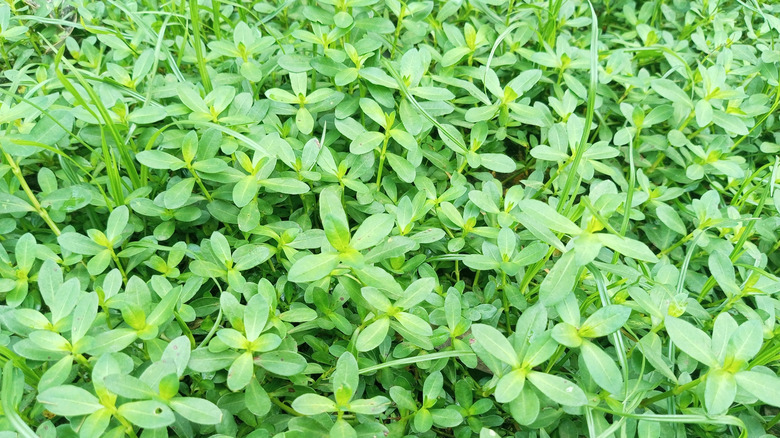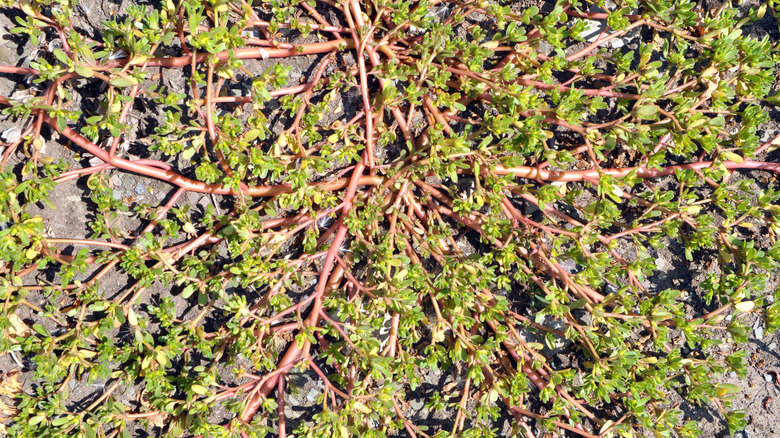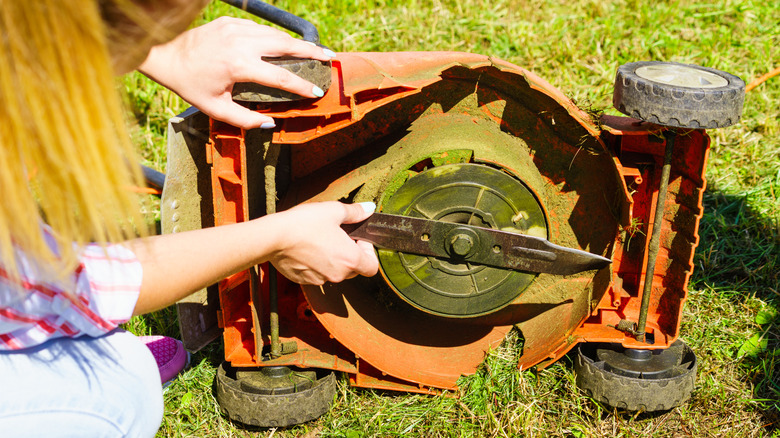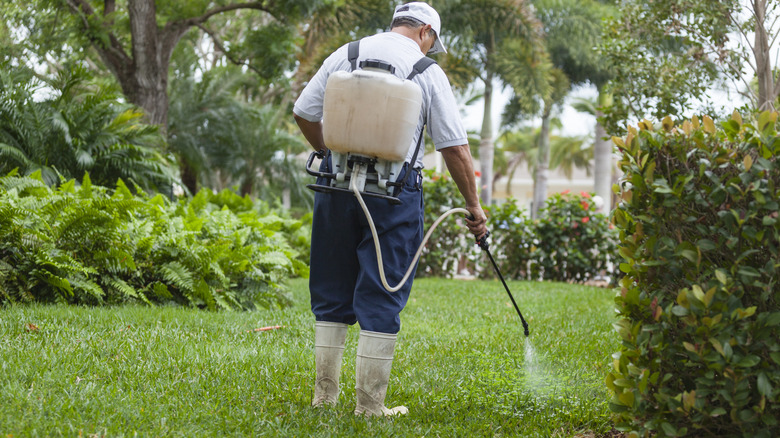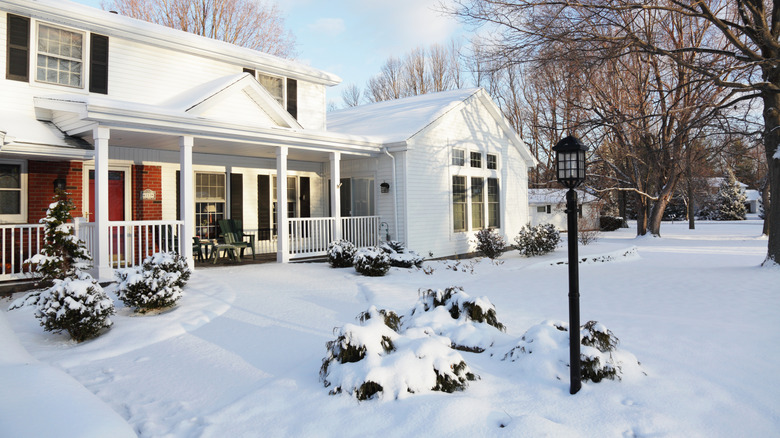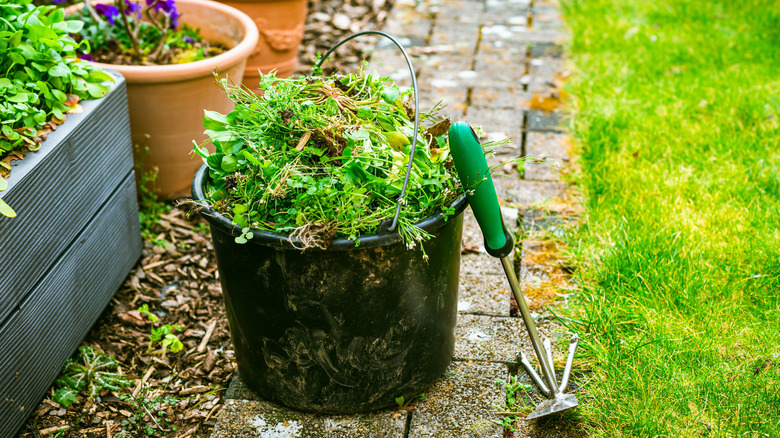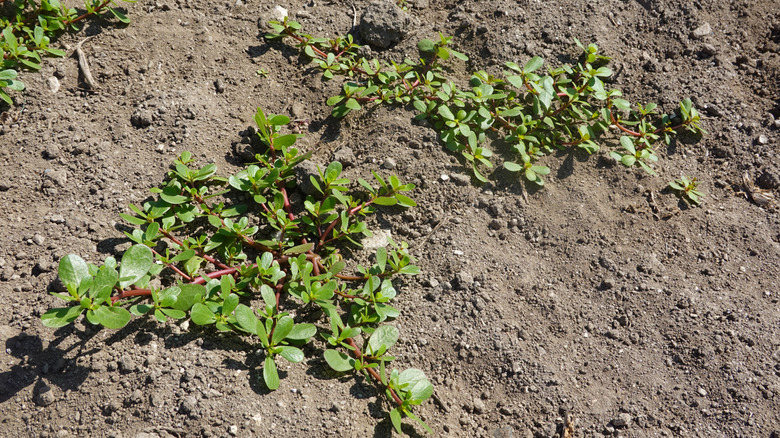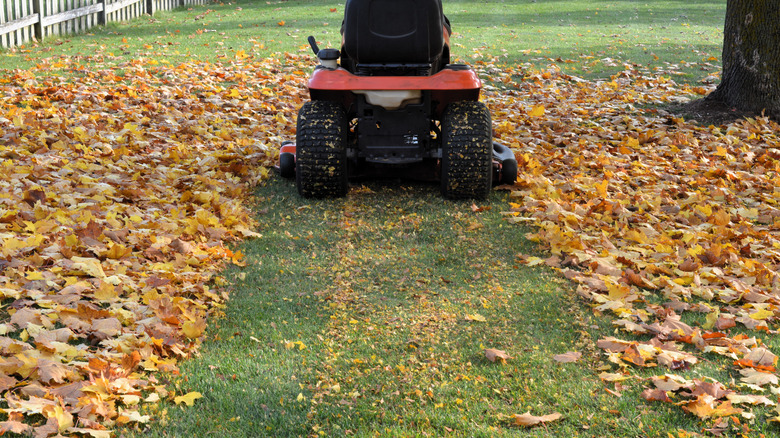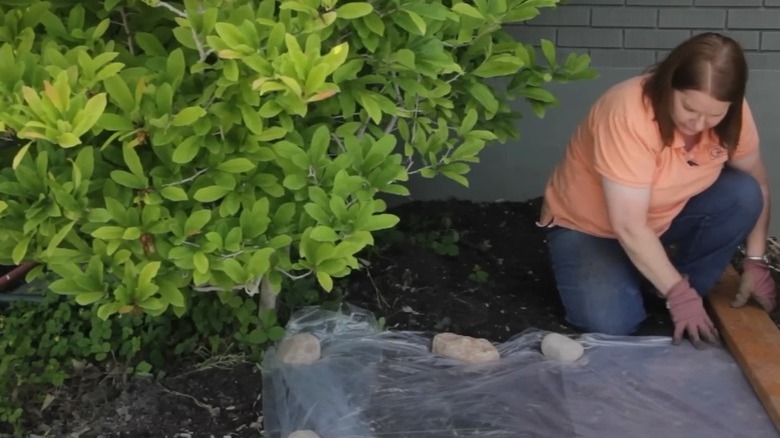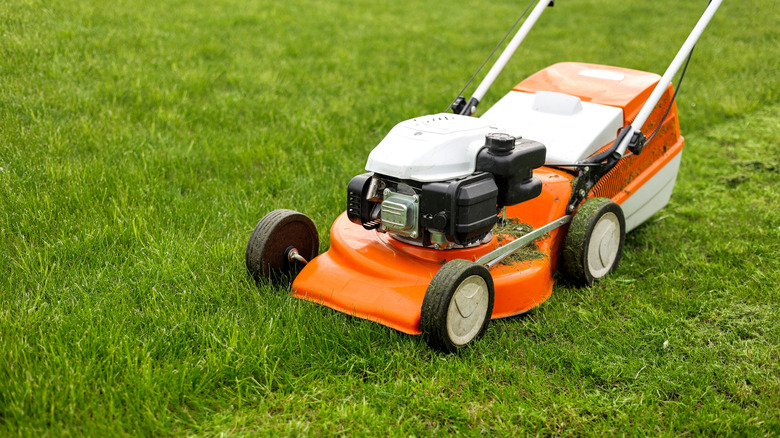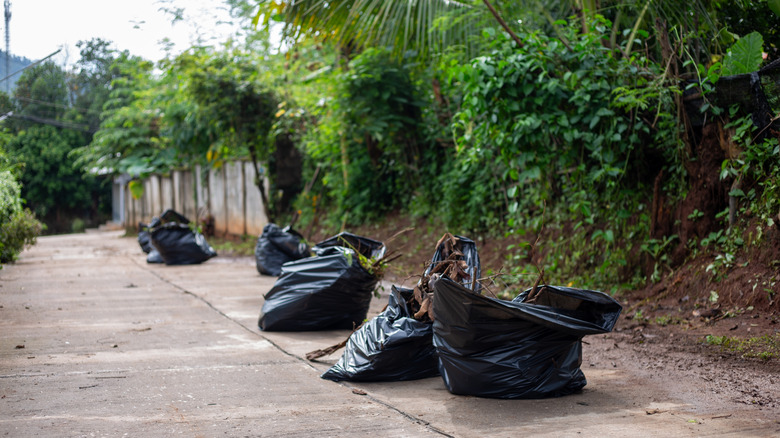Mistakes To Avoid Making When Dealing With Purslane In Your Lawn
We may receive a commission on purchases made from links.
There's no questioning the fact that purslane is a pesky and invasive intruder, ranking high among the most annoying of all common garden weeds. If it is taking over your lawn, you probably want to do whatever you can to clear up the infestation. However, dealing with purslane can be tricky. It is a persistent weed, and if you make a mistake when trying to remove and eradicate it, your efforts may fail. Not only might the weed still end up sticking around, but you may also find that it spreads more quickly and affects new areas of the lawn or garden that weren't previously impacted.
So, how do you avoid making the problem even worse? The first step is to learn about some of the most common mistakes people make when trying to get rid of purslane. Once you've identified these potentially catastrophic purslane pitfalls, you can focus on what you should be doing instead.
Underestimating the devastating effect it can have on your lawn and garden
One of the biggest mistakes you can make when dealing with purslane in your lawn is failing to accurately gauge the extent of the threat it poses. Purslane is not something to be messed around with. Time is really of the essence when treating purslane because of how quickly a few weeds can manifest into a horrible infestation.
Purslane has the ability to reroot itself from sections of stem. This means that even if you dig up the weeds out of your turf, one dropped (or missed) piece of stem and they may reappear. The larger and more widespread the plants, the harder it will be to remove them without stray bits of stem resprouting. Whichever way you approach things, the longer you wait to take the problem seriously, the more difficult it will be to get rid of the weed and keep it from returning. Once established, purslane can steal essential nutrients and water from the turfgrass. It also grows in very dense patches, blocking your turf and other plants from getting the sunlight they need to thrive. Moreover, one purslane plant has the potential to produce more than 200,000 seeds, which could germinate over a span of up to 40 years.
Not taking steps to prevent purslane from becoming a problem in the first place
Now that you know how serious a purslane problem can be, it should be evident that allowing it to spread across your lawn and yard will be a huge mistake. The saying "prevention is better than cure" definitely applies here. To protect your lawn against a purslane infestation, you'll want to be careful to avoid accidentally introducing it in the first place. This means cleaning your mowing and gardening tools if they've been used on other lawns or gardens, particularly those that you know are infested. When you bring in landscaping materials like topsoil or compost to dress your lawn with, or mulch for borders, try to source materials that have the highest possibility of being free of any unwanted weed seeds. For materials like topsoil, it's very hard for sellers to guarantee a product that is 100% seed-free. However, buying from a reputable nursery that you trust is certainly a safer bet than picking up a load of earth from a buddy's backyard that has purslane growing in it.
If you're looking to feed your lawn the nutrients it needs via natural ingredients avoid manure and lawn clippings from other gardens, both of which can introduce weed seeds, and stick to things like bone meal, blood meal, and alfalfa pellets. While alfalfa hay can contain weed seeds as well, the grinding process that turns it into pellets lowers germination by a whopping 99%. If you plan to reseed areas of your lawn, select turfgrass seed that contains less than 1% to 0.5% weed seeds (the percentage should be stipulated on the label).
Finally, if you do spot a purslane plant in your yard, make yourself even more vigilant. Check other areas regularly for any signs of growth and act quickly to remove the weed before it has a chance to produce any seeds that will further exacerbate the problem. Purslane can produce flowers within a few weeks from the seedling stage, so time is of the essence.
Relying on a spring application of pre-emergent herbicide to prevent a purslane problem in your lawn
Pre-emergents are a valuable tool for those looking to bust weeds before they even begin growing. These herbicides are designed to be applied to the lawn before weeds emerge. When these sprays come into contact with weed seeds, they prevent them from being able to germinate. Pre-emergent herbicides are usually applied in the spring to combat annual lawn weeds, which typically germinate as soon as the soil starts to warm up in spring. However, these springtime applications of a pre-emergent probably won't be enough to help you solve a purslane problem. Compared to other weeds, purslane germinates later in the season, so the pre-emergents you applied earlier in the spring may not still be effective by then. To remedy this, you can do a follow-up application in late spring.
Pre-emergents also won't work if they aren't used correctly (and in accordance with the manufacturer's instructions). In addition to applying them to the surface of the soil before the seeds are ready to germinate, you must activate pre-emergents with a light watering, or apply them just before some rain is expected. High temperatures can also cause pre-emergent herbicides to vaporize into the air after application, losing some of their potency, so try to time your application with mild weather. If you do all of this, pre-emergent herbicides can play an effective role in the control of purslane. Some ingredients to look for in a pre-emergent include pendimethalin, dithiopyr, or isoxaben.
In addition to knowing which pre-emergent herbicides can be most effective and how and when they should be applied, it can also be valuable to know which post-emergent herbicides you'll want to have on hand to deal with any seeds that do germinate. Some active ingredients that have been shown to be effective at killing purslane include 2,4-D, clopyralid, and dicamba. As with any other herbicides, be sure to carefully read the directions for use from the manufacturer and protect your skin, eyes, and lungs when applying chemical treatments to your lawn or garden.
Assuming that harsh winter conditions will prevent purslane from being a problem the following summer
So, you managed to deal with a purslane invasion this summer. Now, it is finally winter, and you can rest easy knowing that all of the weeds are dead and you can start off with a clean slate next spring, right? Unfortunately, this isn't the case. Just because the weeds are not currently growing on your lawn during the colder months, it doesn't mean that they're gone for good.
Purslane weeds produce seeds that scatter over your lawn and garden. While the winter temperatures are too cold for these seeds to germinate, they are just lying in wait. Once the summer comes and the temperatures warm back up, they'll be ready to unleash a fresh ambush on your lawn. So, don't get fooled by the disappearance of the weeds during the fall and winter. Be ready with a plan to start attacking them before they reappear in the early summer.
Leaving roots behind when weeding
Whether you're busy removing weeds from your gravel, your lawn, or your garden, try to pull out as many of the roots as possible. This is especially important with purslane. Plants that are already a few inches large can regrow from root segments left in the ground, counteracting your weeding efforts.
The good news is that purslane's root system doesn't grow as deep beneath the surface as some other plants, so you shouldn't have to dig too far down to get it out, and hand pulling is usually effective. However, its taproot is long and has several small roots branching off of it. For the most reliable results when getting rid of weeds in your garden, work carefully to try and remove these lateral roots too. Like the taproot, they may be able to generate a new weed and restart a purslane infestation. There are reports that slicing purslane plants at their base with a hoe or small weeding tool (which is usually better suited to removing weeds in lawns than a hoe which can damage surrounding turf) can also work, but you should revisit the site regularly to make sure that the taproot hasn't resprouted and produced a new plant.
Trying to weed when the soil is too dry
While you want to act quickly once you identify a purslane problem in your lawn or garden, you should avoid pulling the weeds from dry soil. If the soil is too dry, you're much more likely to break the tap root when pulling purslane out of the ground. As mentioned above, this could result in new weeds quickly taking the space of the ones you pulled out of the soil.
Instead, try weeding a few days after it has rained. This way, the soil will be moist enough that you'll be able to dig out the root successfully and won't have to worry about it snapping as you pull on the weed. There is one important caveat to keep in mind. While moist soil is ideal, you should not try to weed if the soil is fully saturated or covered with puddles. These conditions can also increase the likelihood that a piece of the root will be left behind, allowing the purslane to potentially regenerate and take over again.
Overlooking the benefits of mulching to control purslane
There are many ways to use mulch in your yard and garden. And one that you must not overlook is utilizing it to help control purslane. Covering purslane weeds and seeds with mulch can suppress their growth. The mulch cover will turn the area surrounding the plants into one that is humid and shaded. Purslane does not grow well under such conditions, and, instead, is more likely to rot and die. There is one drawback to this technique, however. It can be tricky to use on turf. You don't want to cover areas of your turf grass with thick layers of mulch, as it too can die without light. Instead, you only want to cover the purslane plants thickly. Therefore, this method works best if you have big bare patches on your lawn where purslane keeps popping up. Mulching over these could help kill existing plants and suppress new seedlings. Over time, the grass should begin to infiltrate from the sides. You can either remove the mulching slowly, or let some of it break down to form organic matter in the soil. Another method you can try is applying a lawn patch product that contains mulch and turfgrass seed, such as the Growtrax Biodegradable Grass Seed Mat. It's available at Lowe's, Menards, and The Home Depot, but Amazon offers the cheapest price. Leaf mulching is another option to consider. While this technique might not kill germinated purslane plants, it may help suppress seed germination, and, at the very least, will give your lawn a nice dressing of organic matter.
Besides addressing your lawn, mulching any garden beds and borders is also a good idea. It can prevent purslane from popping up in these areas, and help reduce the chances of it spreading back into your lawn via any seeds. There are some other important caveats to consider before you start putting mulch down. The mulch you choose (here's how to select the best type of mulch for your garden), must effectively screen out light to prevent new seeds from germinating or existing plants from continuing to grow. To achieve this goal, spread a layer of mulch that is at least 3 inches thick. If bringing in organic materials to mulch garden beds with (like straw or utility mulch), source ones that have the least chance of containing new weed seeds, either from purslane or other pesky plants.
Relying on solarization to kill purslane
Solarization is sometimes recommended as an organic, chemical-free weed control solution. The process relies on radiant heat killing weeds that are trapped beneath clear plastic sheeting. When utilized during July and August, the hottest months of the summer, the temperature beneath the plastic can get hot enough to kill many weeds. If you've heard about this method, or even had success trying it with a different type of weed, you might assume that it will deliver similar benefits for clearing up your purslane problem.
However, setting such high hopes would be a mistake. Solarization is not generally viewed as an effective method for killing purslane. The problem is that the weed is so resilient that even the extreme heat and drought-like conditions that are created by the plastic sheeting aren't always sufficient to eradicate the problem. What's more, if any areas of turf end up under the plastic sheeting, they might die (or at the very least be severely compromised) — leaving you with less lawn and a persisting purslane problem.
Not focusing on the overall health of your turf
When you're dealing with a purslane infestation, it is easy to focus all your time and energy towards getting rid of the weeds. However, doing so is a mistake that could end up making your problem worse. Purslane is much more common in turfgrass which is not very healthy or well-maintained. Therefore, one of the best ways to keep fast-growing purslane out of your lawn is to address the overall health of your turf.
Focus on making your lawn denser and fuller. With a dense lawn, there will be more impediments blocking the weed from spreading and taking over. Some measures you can take to increase density include fertilizing the grass and keeping up with a regular mowing schedule. It is also important to make sure that you aren't cutting your grass too short. The longer the blades of grass are, the longer the root system is (and the better it will be able to outcompete purslane). Overly short lawns that have been "scalped" by mowing also let more light down to the soil surface, encouraging the germination of weed seeds. Depending on the type of grass you have, the ideal height may be between ½ and 4 inches. For example, some warm-season grasses, such as zoysiagrass, should be mowed to a height of around ½ to 1 inch, while cool-season grasses should be mowed closer to a height of 3 inches.
Failing to dispose of pulled weeds properly
Earlier, we mentioned that hand-pulling purslane is one of the ways to keep the weeds from spreading across your yard. But once you've pulled the weeds from your lawn, they could re-establish themselves if you don't dispose of them properly. If any of the cut stems from the weed are left behind in your yard or garden, they may re-root themselves, flower, produce seed, and erase all of the hard work you put into clearing out the space. This remains true even if you leave the weed out with the root side up.
Clearly, this is not a problem you want to deal with, so learning how to properly dispose of purslane is essential. First, you must take care to contain the plants as you're weeding. Remember, the seeds can stay viable in the soil for up to 40 years, so you want to avoid spreading them around. As soon as you pull a weed, immediately place it in a heavy trash bag instead of laying it on the ground. Once you've finished collecting the weeds, tie the bag tightly and throw it away. You can also consider burning purslane to dispose of it, but make sure you secure any necessary permits for your area. Avoid composting purslane as the seeds may still germinate and scatter back across your yard.
